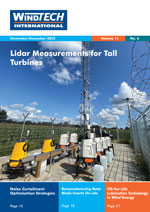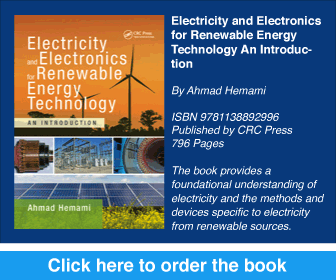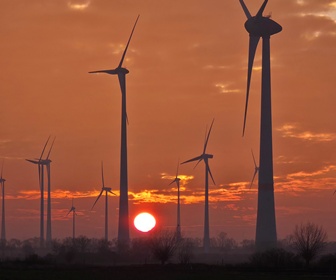- Category: Articles
A Non-Battery, Air-to-Air Hybrid System
 In this article, R.S. Chauhan discusses his ideas for a long-duration (up to 90 days) non-battery air-to-air hybrid back-up system which converts and stores wind energy into an acceptable form during windy periods. This stored energy can then be released to rotate small wind (aero) generators when there is no wind or the wind speed is below the critical velocity. Such a system could ensure the availability of power from wind generators at all times.
In this article, R.S. Chauhan discusses his ideas for a long-duration (up to 90 days) non-battery air-to-air hybrid back-up system which converts and stores wind energy into an acceptable form during windy periods. This stored energy can then be released to rotate small wind (aero) generators when there is no wind or the wind speed is below the critical velocity. Such a system could ensure the availability of power from wind generators at all times.By R.S. Chauhan, India
.- Category: Articles
Wind Power Anywhere
 The Magenn Air Rotor System ‘MARS’ is a Wind Power Anywhere solution with certain advantages over existing conventional wind turbines and diesel generating systems. These advantages include global deployment, low costs, good operational performance and environmental benefits. The article describes the features of the system, and its history and development, quoting extensively from the words of its creator, Fred Ferguson, before listing the advantages and market that Magenn foresee for this system.
The Magenn Air Rotor System ‘MARS’ is a Wind Power Anywhere solution with certain advantages over existing conventional wind turbines and diesel generating systems. These advantages include global deployment, low costs, good operational performance and environmental benefits. The article describes the features of the system, and its history and development, quoting extensively from the words of its creator, Fred Ferguson, before listing the advantages and market that Magenn foresee for this system.By Mac Brown, CEO Magenn Power, Canada
- Category: Articles
A Case Study
 Based on a real case study, this article addresses the issues that can be encountered during project planning when a wind resource assessment programme (WRAP) is not adequately designed. The study highlights the uncertainty induced by vertical and horizontal extrapolation of the wind resource. The impact of these parameters on energy production is demonstrated based on simulations using commercial wind resource models. The resulting conclusions highlight the importance of well-designed WRAPs. The experience, results, benefits and challenges of sodar (sound detection and ranging) use are briefly reviewed in the context of the complex terrain and operating conditions of Canada. Limitations encountered by numerical models (steady state wind flow model, CFD model) are also examined in a comparative case study.
Based on a real case study, this article addresses the issues that can be encountered during project planning when a wind resource assessment programme (WRAP) is not adequately designed. The study highlights the uncertainty induced by vertical and horizontal extrapolation of the wind resource. The impact of these parameters on energy production is demonstrated based on simulations using commercial wind resource models. The resulting conclusions highlight the importance of well-designed WRAPs. The experience, results, benefits and challenges of sodar (sound detection and ranging) use are briefly reviewed in the context of the complex terrain and operating conditions of Canada. Limitations encountered by numerical models (steady state wind flow model, CFD model) are also examined in a comparative case study.By Bouaziz Ait-Driss, Francis Pelletier, Milena Dimitrijevic and Christophe Sibuet-Watters, Helimax Energy, Canada
- Category: Articles
A New Option for Wind Integration?
This article presents a recent analysis of wind energy integration into the electricity systems of Germany and Austria. It raises the question of whether flexible demand can provide cheap balancing options to fulfil the growing need for balancing capacity. The main focus is on the interaction of wind power production and flexible demand to im-prove the total system efficiency. Detailed simulations of wind power production and power plant operation are used to quantify additional reserve power, which, next to grid extension, is the main issue concerning the integration of wind energy. An assessment of demand response potentials provided evidence that the costs of additional reserve power could be reduced and that demand response can be a valuable option for inte-grating wind power into electricity systems.
By Marian Klobasa, Fraunhofer Institute for Systems and Innovation Research, Germany
- Category: Articles
Reconciling a conflict between wind turbines and radio systems
 Renewable energy is at the heart of government policy in most western countries as global warming and its causes rise to the top of political and public agendas.? At the same time, the public demand for further growth in communications and more mobility seems as insatiable as increased demand for energy.? But within these public aspirations lies a dilemma: wind turbines, the major source of growth in renewable energy, cause interference to radio communications upon which many telecommunication services depend.? Can these conflicts be resolved?? Radio engineers, recognising the importance of both renewable energy and radio communications are seeking ways to reconcile this conflict.
Renewable energy is at the heart of government policy in most western countries as global warming and its causes rise to the top of political and public agendas.? At the same time, the public demand for further growth in communications and more mobility seems as insatiable as increased demand for energy.? But within these public aspirations lies a dilemma: wind turbines, the major source of growth in renewable energy, cause interference to radio communications upon which many telecommunication services depend.? Can these conflicts be resolved?? Radio engineers, recognising the importance of both renewable energy and radio communications are seeking ways to reconcile this conflict.By Adrian Grilli, the Joint Radio Company Ltd, UK
.- Category: Articles
Assessing the Costs and Possibilities
 At the present time 65% of Sri Lanka's electricity is generated by fossil fuels. In this situation, utilisation of renewable energy for electricity generation is very important to mitigate economic and environmental impacts. Wind energy has been identified as one of the more promising renewable energy sources that could generate electricity in Sri Lanka. However, it will be necessary to improve the quality and accessibility of renewable energy resource data before large-scale wind energy technologies can be developed locally. At present, ground wind measurements are not sufficient to accomplish a comprehensive wind resource assessment in Sri Lanka. For this reason, a high-resolution wind map has been developed by the US National Renewable Energy Laboratory. In this article, cost of wind power generation in various parts of Sri Lanka is discussed and compared to the existing power purchasing tariff system in the country.
At the present time 65% of Sri Lanka's electricity is generated by fossil fuels. In this situation, utilisation of renewable energy for electricity generation is very important to mitigate economic and environmental impacts. Wind energy has been identified as one of the more promising renewable energy sources that could generate electricity in Sri Lanka. However, it will be necessary to improve the quality and accessibility of renewable energy resource data before large-scale wind energy technologies can be developed locally. At present, ground wind measurements are not sufficient to accomplish a comprehensive wind resource assessment in Sri Lanka. For this reason, a high-resolution wind map has been developed by the US National Renewable Energy Laboratory. In this article, cost of wind power generation in various parts of Sri Lanka is discussed and compared to the existing power purchasing tariff system in the country.By Mahinsasa Narayana, National Engineering Research & Development Centre, Sri Lanka
.- The European Offshore Supergrid
- Wind Energy Forecasting in Ireland
- Reliable Ultimate Loads for Wind Turbines
- A Computational Tool to Aid the Electric Power Utilities
- Clipper’s Liberty Turbine
- Reducing Dynamic Loading of Towers
- Wind Turbines and Earthquakes
- Generating Wind Energy Using Kites
- Technology to Catch the Wind
- Sahara Wind’s Integrated Development Approach
- Wind Energy and Hydrogen Balancing
- Damage on Wind Turbines
- Brakes in Modern Wind Turbines
- A Fresh Breeze for Gears
- GyroTorque, Continuously Variable Transmission (GTCVT)
- Cost of Lost Production
- The Sound of an Endless Train
- SmartEnergy Spire
- A Motion Compensated Platform for Wind Turbine Maintenance
- Zephyr’s ‘Airdolphin’
- Increased Performance by Condition Monitoring of Rotor Blades
- Offshore Winds Observed from Space
- Improving Wind Energy’s Market Penetration
- Measurement at 80 Metres with a New Design Wind Mast
- Turbine Shortages and Rising Costs Stall Development
- Aerodynamic Damping
- Sharing the Sea
- Offshore Wind Farm Layout Optimisation
- New BAUER Flydrill system
- Investigation of Stability Effects of an Offshore Wind Turbine










